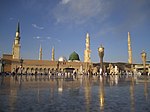Meccan boycott of the Hashemites
It is proposed that this article be deleted because of the following concern:
If you can address this concern by improving, copyediting, sourcing, renaming, or merging the page, please and do so. You may remove this message if you improve the article or otherwise object to deletion for any reason. Although not required, you are encouraged to explain why you object to the deletion, either in your edit summary or on the talk page. If this template is removed, do not replace it. The article may be deleted if this message remains in place for seven days, i.e., after 18:44, 25 March 2022 (UTC). Find sources: – · · · scholar · JSTOR |
- This is a sub-article to Muhammad before Medina
The Meccan banishment of the Hashemites was a public banishment against the clan of Banu Hashim, declared in 616 (7th year of Prophethood) by the leaders of Banu Makhzum and Banu Abd-Shams, two important clans of Quraysh. According to tradition, the banishment was carried out in order to put pressure on Banu Hashim to withdraw its protection from Muhammad.[1][2]
The terms imposed on Banu Hashim, as reported by Ibn Ishaq, were "that no one should marry their women nor give women for them to marry; and that no one would trade with them, and when they agreed on that they wrote it in a deed."[3] The banishment lasted for three years but eventually collapsed mainly because it was not achieving its purpose; the banishment had caused extreme privation and the sympathizers within the Quraysh finally united to annul the agreement.[2][4]
Overview[]
It became a source of great troubles for the Muslims. They were forced to do their second migration to an area called or where they suffered hunger.[5] The boycott was ended in 619, the Year of Sorrow.
History[]
...These days were very hard with them and very often they had to feed on the leaves TALH or plantain" [6]
The banishment included even Hashemites that had not accepted Islam.[7] [8]
References[]
- ^ Francis E. Peters, The Monotheists: Jews, Christians, and Muslims in Conflict and Competition, p.96
- ^ a b Moojan Momen, An Introduction to Shi'i Islam: The History and Doctrines of Twelver Shiʻism, Yale University Press, p.4
- ^ Francis E. Peters, Mecca: A Literary History of the Muslim Holy Land, Princeton University Press, 1994, ISBN 0-691-03267-X, p.54
- ^ Daniel W. Brown,A New Introduction to Islam, Blackwell Publishing, p.76, 2004, ISBN 0-631-21604-9
- ^ "Answering-Ansar.org :: Our 20 questions". Archived from the original on 2006-08-24. Retrieved 2006-07-25.
- ^ taken from by Shibli Numani Vol 1 p 218, English translation by [1] Archived 2006-08-24 at the Wayback Machine
- ^ www.islam4theworld.com
- ^ Taken from Tarikh al-Tabari, Volume 6 page 81 - Muhammad at Mecca (book), translated by William Montgomery Watt & [2] Archived 2006-08-24 at the Wayback Machine
- Life of Muhammad

